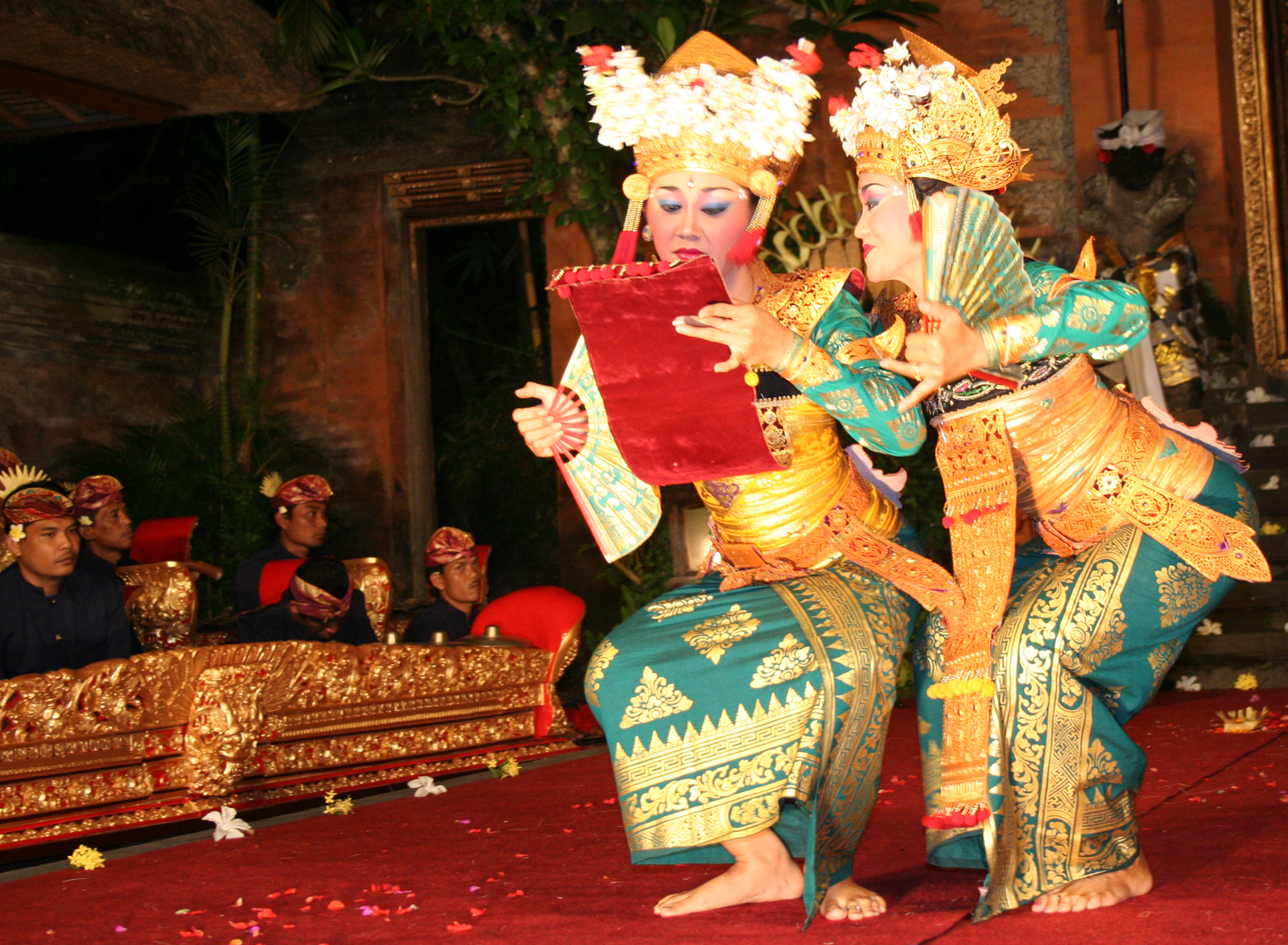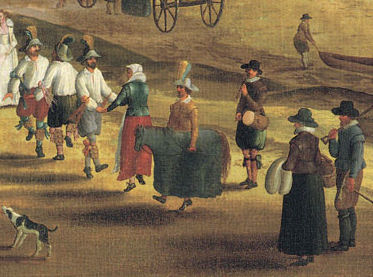|
Sanghyang Swawarcinta
( ban, ᬲᬂᬳ᭄ᬬᬂ) is a traditional sacred Balinese dance originated from the Indonesian island of Bali, it is based on the premise that an unseen force enters the body of an entranced performer. The force, identified as ''hyang'', is an important type of spiritual entity in ancient Indonesian mythology. The ''sanghyang'' dances are considered sacred ritual dances and are performed exclusively at Balinese religious ceremonies. Variants ''Sanghyang bojog'' The dancer is a man dressed like a monkey (''bojog'') and accompanied by a chorus of chanting ''sanghyang''. Before it begins, the dancer goes through the phases of summoning ape spirits. After conceding, the dancer will jump into a tree and mimic the behavior of an ape. This dance is only found in Bugbug, Karangasem. ''Sanghyang celeng'' This is a ''sanghyang'' dance variant only found in Duda, Karangasem, danced by a man wearing palm fiber clothing. The dancer mimics the movements of a pig. ''Sanghyang d ... [...More Info...] [...Related Items...] OR: [Wikipedia] [Google] [Baidu] |
Balinese Dance
Balinese dance ( id, Tarian Bali; ban, ᬇᬕᬾᬮᬦ᭄ᬩᬮᬶ) is an ancient dance tradition that is part of the religious and artistic expression among the Balinese people of Bali island, Indonesia. Balinese dance is dynamic, angular and intensely expressive. Balinese dancers express the stories of dance-drama through the bodily gestures including gestures of fingers, hands, head and eyes. There is a great richness of dance forms and styles in Bali; and particularly notable are those ritualistic dance dramas which involve Rangda, the witch, and the great beast Barong. Most of the dances in Bali are connected to Hindu or traditional folk rituals, such as the Sanghyang Dedari sacred dance that invoke benevolent hyang spirits, believed to possess the dancers in a trance state during the performance. Other Balinese dances are not linked to religious rituals and are created for certain occasions or purposes, such as the Baris or Pendet welcoming dances and Joged dance, ... [...More Info...] [...Related Items...] OR: [Wikipedia] [Google] [Baidu] |
Joged
''Joged'' dance ( ban, ᬚᭀᬕᬾᬤ᭄) is a style of dance from the Island of Bali derived from the traditional Gandrung dance. The term ''joged'' or ''joget'' is also a common word for dance in Indonesia. The dance is typically accompanied by a gamelan ensemble of bamboo instruments called a gamelan joged bumbung. Dancers usually wear attire consisting of a Kebaya and Sarong Unlike most Balinese dance, ''joged'' is not a religious and ritual one, it is a secular social dance for entertainment purposes only. During a ''joged'' performance, a single or several female dancers will perform for usually predominantly male audience to dance with them. Dancers may often invite a spectator to join in the ''joged'' using a fan and sash. which unlike many dances has no set moves and is largely improvised. It is considered impolite to refuse such an invitation. The dance often involves erotic movements and teasing, ranging from humorous to seductive interactions between the dance ... [...More Info...] [...Related Items...] OR: [Wikipedia] [Google] [Baidu] |
Footnotes
A note is a string of text placed at the bottom of a page in a book or document or at the end of a chapter, volume, or the whole text. The note can provide an author's comments on the main text or citations of a reference work in support of the text. Footnotes are notes at the foot of the page while endnotes are collected under a separate heading at the end of a chapter, volume, or entire work. Unlike footnotes, endnotes have the advantage of not affecting the layout of the main text, but may cause inconvenience to readers who have to move back and forth between the main text and the endnotes. In some editions of the Bible, notes are placed in a narrow column in the middle of each page between two columns of biblical text. Numbering and symbols In English, a footnote or endnote is normally flagged by a superscripted number immediately following that portion of the text the note references, each such footnote being numbered sequentially. Occasionally, a number between brack ... [...More Info...] [...Related Items...] OR: [Wikipedia] [Google] [Baidu] |
Ronggeng
Ronggeng ( jv, ꦫꦺꦴꦁꦒꦺꦁ, translit=ronggèng) is a type of Javanese dance in which couples exchange poetic verses as they dance to the music of a rebab or violin and a gong. Ronggeng might have originated from Java in Indonesia. Ronggeng probably has existed in Java since ancient time, the bas reliefs in Karmawibhanga section on eighth century Borobudur displays the scene of travelling entertainment troupe with musicians and female dancers. In Java, a traditional ronggeng performance features a traveling dance troupe that travels from village to village. The dance troop consists of one or several professional female dancers, accompanied by a group of musicians playing musical instruments: rebab and gong. The term "ronggeng" also applied for this female dancers. During a ronggeng performance, the female professional dancers are expected to invite some male audiences or clients to dance with them as a couple with the exchange of some tips money for the female dancer, giv ... [...More Info...] [...Related Items...] OR: [Wikipedia] [Google] [Baidu] |
Kecak
''Kecak'' (pronounced ("kechak"), alternate spellings: ''kechak'' and ''ketjak''), known in Indonesian as ''tari kecakilolahhe'', is a form of Balinese Hindu dance and music drama that was developed in the 1930s in Bali, Indonesia. Since its creation, it has been performed primarily by men, with the first women's ''kecak'' group having started in 2006. The dance is based on the story of the ''Ramayana'' and is traditionally performed in temples and villages across Bali. Also known as the Ramayana monkey chant, the dance is performed by a circle of as many as 150 performers wearing checked cloths around their waists, percussively chanting "''chak''" and moving their hands and arms. The performance depicts a battle from the ''Ramayana'', in which the monkey-like Vanaras, led by Hanuman, help Prince Rama fight the evil King Ravana. ''Kecak'' has roots in ''sanghyang,'' a trance-inducing exorcism dance. History ''Kecak'' was originally a trance ritual accompanied by a male chor ... [...More Info...] [...Related Items...] OR: [Wikipedia] [Google] [Baidu] |
Hobby Horse
The term "hobby horse" is used, principally by folklorists, to refer to the costumed characters that feature in some traditional seasonal customs, processions and similar observances around the world. They are particularly associated with May Day celebrations, mummers' plays and the Morris dance in England. Etymology The word ''hobby'' is glossed by the OED as "a small or middle-sized horse; an ambling or pacing horse; a pony." The word is attested in English from the 14th century, as Middle English ''hobyn''. Old French had ''hobin'' or ''haubby'', whence Modern French ''aubin'' and Italian ''ubino''. But the Old French term is apparently adopted from English rather than vice versa. OED connects it to "the by-name ''Hobin'', ''Hobby''", a variant of ''Robin''" (compare the abbreviation ''Hob'' for ''Robert''). This appears to have been a name customarily given to a cart-horse, as attested by White Kennett in his ''Parochial Antiquities '' (1695), who stated that "Our ploughm ... [...More Info...] [...Related Items...] OR: [Wikipedia] [Google] [Baidu] |
Ritual
A ritual is a sequence of activities involving gestures, words, actions, or objects, performed according to a set sequence. Rituals may be prescribed by the traditions of a community, including a religious community. Rituals are characterized, but not defined, by formalism, traditionalism, invariance, rule-governance, sacral symbolism, and performance. Rituals are a feature of all known human societies. They include not only the worship rites and sacraments of organized religions and cults, but also rites of passage, atonement and ritual purification, purification rites, oaths of allegiance, dedication ceremonies, coronations and presidential inaugurations, marriages, funerals and more. Even common actions like handshake, hand-shaking and saying "hello" may be termed as ''rituals''. The field of ritual studies has seen a number of conflicting definitions of the term. One given by Kyriakidis is that a ritual is an outsider's or "Emic and etic, etic" category for a set activity (o ... [...More Info...] [...Related Items...] OR: [Wikipedia] [Google] [Baidu] |
Legong
Legong ( Balinese: ) is a form of Balinese dance. It is a refined dance form characterized by intricate finger movements, complicated footwork, and expressive gestures and facial expressions. Origins Legong probably originated in the 19th century as royal entertainment. Legend has it that a prince of Sukawati fell ill and had a vivid dream in which two maidens danced to gamelan music. When he recovered, he arranged for such dances to be performed in reality. Others believe that the Legong originated with the ''sanghyang dedari'', a ceremony involving voluntary possession of two little girls by beneficent spirits. Legong is also danced at public festivals. Excerpts from Legong dance dramas are put on for tourists. Dancers Traditionally, legong dancers were girls who have not yet reached puberty. They begin rigorous training from about the age of five. These dancers are regarded highly in the society and usually become wives of royal personages or wealthy merchants. After marriag ... [...More Info...] [...Related Items...] OR: [Wikipedia] [Google] [Baidu] |
Karangasem Regency
Karangasem Regency (Indonesian: ''Kabupaten Karangasem'') is a regency (''kabupaten'') of Bali, Indonesia. It covers the east part of Bali, has an area of 839.54 km2 and had a population of 396,487 at the 2010 Census which rose to 492,402 at the 2020 Census. Its regency seat is the town of Amlapura. Karangasem was devastated when Mount Agung erupted in 1963, killing 1,900 people. Karangasem was a kingdom before Bali was conquered by the Dutch. Administrative districts The regency is divided into eight districts (''kecamatan''), tabulated below with their areas and population totals at the 2010 Census and the 2020 Census. The table also includes the number of administrative villages (rural ''desa'' and urban ''kelurahan'') in each district, and its postal codes. Note: (a) including 6 small offshore islands. Tourism Interesting places include: * The major Pura Besakih Hindu temple, sometimes called the Mother Temple of Besakih. * Mount Agung, the highest peak in ... [...More Info...] [...Related Items...] OR: [Wikipedia] [Google] [Baidu] |
Bugbug
Bugbug is an area of Karangasem Regency, Bali. Indonesia. It is located east of Candidasa Candi Dasa, or often Candidasa is a seaside town on the eastern cost of Bali that rests on the edge of a fresh water lagoon, named Candi Dasa Lagoon. The town is centred around ''Jalan Raya Candida'', where a number of hotels, restaurants, and s ... and its inhabitants celebrate the ''Perang Dawa'' (war of the gods) every other year at full moon of the fourth month (October). People from nearby villages then climb to the top of a hill and sacrifice pigs by hanging them in trees. A beach is hidden among two cliffs / hills, Bugbug Cliff and Prasi Cliff. References {{coord, 8.4833, S, 115.5833, E, source:wikidata, display=title Geography of Bali ... [...More Info...] [...Related Items...] OR: [Wikipedia] [Google] [Baidu] |
Balinese Temple
A pura is a Balinese Hindu temple, and the place of worship for adherents of Balinese Hinduism in Indonesia. Puras are built in accordance to rules, style, guidance and rituals found in Balinese architecture. Most puras are found on the island of Bali, where Hinduism is the predominant religion; however many puras exist in other parts of Indonesia where significant numbers of Balinese people reside. Mother Temple of Besakih is the most important, largest and holiest temple in Bali. Many puras have been built in Bali, leading it to be titled "the Island of a Thousand Puras". Etymology The term ''pura'' originates from the Sanskrit word ('' -pur, -puri, -pura, -puram, -pore''), meaning "city", "walled city", "towered city", or "palace", which was adopted with the Indianization of Southeast Asia and the spread of Hinduism, specially in the Indosphere. During the development of the Balinese language the term ''pura'' came to refer to a religious temple complex, while the term ' ... [...More Info...] [...Related Items...] OR: [Wikipedia] [Google] [Baidu] |






